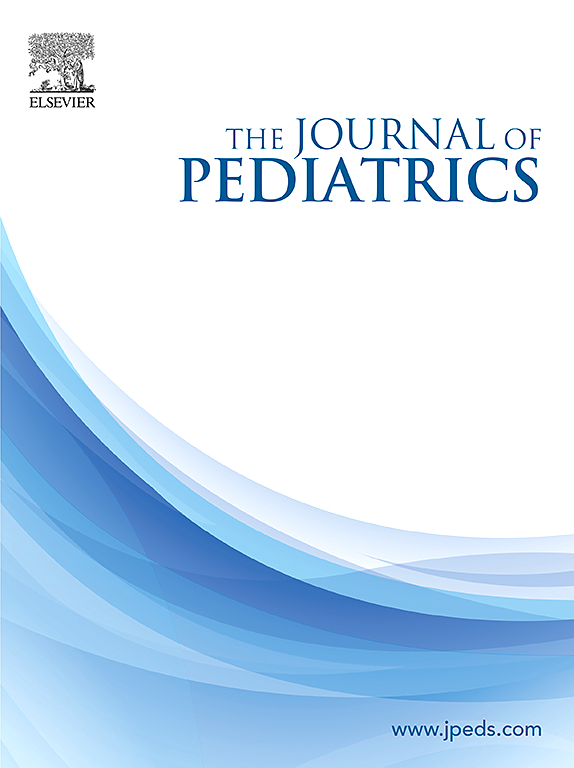Race Is an Incomplete Surrogate for Skin Pigmentation in Neonates, with Potential Relevance for Pulse Oximetry
IF 3.5
2区 医学
Q1 PEDIATRICS
引用次数: 0
Abstract
Objective
To examine the objective differences and overlap in skin pigment among neonates born to mothers of different racial groups.
Study design
We conducted a prospective study assessing neonatal skin tone by spectrophotometry using SkinColorCatch (Delfin, Miami, FL) at the pulse oximetry site (dorsum of foot) in neonatal and cardiac intensive care units. Colorimetric indices were compared between non-Hispanic Black (NHB) and non-Hispanic White (NHW) neonates using Welch's t test. Distribution overlap was evaluated using the overlap coefficient and the probability of a higher value. Bivariate regression assessed the relationships between colorimetric indices and neonatal characteristics, including gestational age and birth weight. A P value of <.05 was considered significant.
Results
Among 100 neonates (33 NHB, 57 NHW, 7 Hispanic, 3 other), skin darkness measures (melanin index, perceived lightness, and individual typology angle [ITA°]) were significantly different between NHB and NHW infants. However, substantial overlap was observed: overlap coefficient of 0.66 (95% CI, 0.51-0.83) for the melanin index and 0.73 (95% CI, 0.57-0.90) for the ITA°. The probability of higher value was 0.27 (melanin index) and 0.69 (ITA°), further demonstrating overlap. Lower gestational age and birth weight correlated with darker skin tone characteristics and this association did not differ significantly by race.
Conclusions
Despite statistical differences, NHB and NHW neonates exhibit substantial overlap in objectively assessed skin color. These findings support the use of direct skin pigmentation measurements in device accuracy studies rather than race-based classifications, helping to decrease bias in medical algorithms and device research.
种族是新生儿皮肤色素沉着的不完全替代物,与脉搏血氧测定有潜在的相关性。
目的:探讨不同种族母亲所生新生儿皮肤色素的客观差异和重叠。研究设计:我们进行了一项前瞻性研究,使用SkinColorCatch (Delfin, Miami, FL)在新生儿和心脏重症监护病房的脉搏血氧仪部位(足背)用分光光度法评估新生儿肤色。采用Welch’st检验比较非西班牙裔黑人(NHB)和非西班牙裔白人(NHW)新生儿的比色指标。利用重叠系数(OVL)和高值概率对分布重叠度进行评价。双变量回归评估了比色指数与新生儿特征之间的关系,包括胎龄(GA)和出生体重。结果:100例新生儿(NHB组33例,NHW组57例,Hispanic组7例,Other组3例)的皮肤暗度指标(黑色素指数、感知亮度[L*]、个体类型学角度[ITA°])在NHB组和NHW组之间存在显著差异。然而,观察到大量重叠:黑色素指数的OVL为0.66 (95% CI: 0.51, 0.83), ITA°的OVL为0.73 (95% CI: 0.57, 0.90)。较高值的概率为0.27(黑色素指数)和0.69 (ITA°),进一步表明重叠。较低的GA和出生体重与较深的肤色特征相关,这种关联在种族之间没有显著差异。结论:尽管统计上存在差异,但NHB和NHW新生儿在客观评估的肤色上表现出大量重叠。这些发现支持在设备准确性研究中使用直接的皮肤色素沉着测量,而不是基于种族的分类,有助于减少医疗算法和设备研究中的偏见。
本文章由计算机程序翻译,如有差异,请以英文原文为准。
求助全文
约1分钟内获得全文
求助全文
来源期刊

Journal of Pediatrics
医学-小儿科
CiteScore
6.00
自引率
2.00%
发文量
696
审稿时长
31 days
期刊介绍:
The Journal of Pediatrics is an international peer-reviewed journal that advances pediatric research and serves as a practical guide for pediatricians who manage health and diagnose and treat disorders in infants, children, and adolescents. The Journal publishes original work based on standards of excellence and expert review. The Journal seeks to publish high quality original articles that are immediately applicable to practice (basic science, translational research, evidence-based medicine), brief clinical and laboratory case reports, medical progress, expert commentary, grand rounds, insightful editorials, “classic” physical examinations, and novel insights into clinical and academic pediatric medicine related to every aspect of child health. Published monthly since 1932, The Journal of Pediatrics continues to promote the latest developments in pediatric medicine, child health, policy, and advocacy.
Topics covered in The Journal of Pediatrics include, but are not limited to:
General Pediatrics
Pediatric Subspecialties
Adolescent Medicine
Allergy and Immunology
Cardiology
Critical Care Medicine
Developmental-Behavioral Medicine
Endocrinology
Gastroenterology
Hematology-Oncology
Infectious Diseases
Neonatal-Perinatal Medicine
Nephrology
Neurology
Emergency Medicine
Pulmonology
Rheumatology
Genetics
Ethics
Health Service Research
Pediatric Hospitalist Medicine.
 求助内容:
求助内容: 应助结果提醒方式:
应助结果提醒方式:


